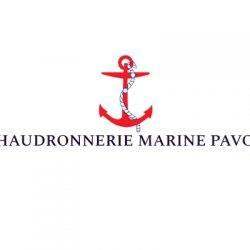Despite its size, Antibes has lots of attractions and activities to enjoy. Look past the town remparts and port, and you can delve into some interesting things to see and do in Antibes.
A brief history of Antibes
The Greeks set up their trading post of Antipolis in the 5th century. Ligurian tribes fought to take control of the town, forcing Antibes’ citizens to turn to Rome for protection in 154 BC. The fall of Rome left Antibes open to attacks from everyone such as the Barbarians, Visigoths and Franks.
In the 10th century, Antibes fell into the hands of the Counts of Grasse before passing to the bishops of Antibes and a few centuries later, the Grimaldis of Monaco. Fort Carré was constructed to counter the Savoy threat – Louis XIV’s military architect Vauban gave it its 8-pointed star shape. The town remained the Grimaldis until the early 17th century, when Henri IV of France bought Antibes, turning the town into his front-line defence post agains the Savoy kingdom across the bay in Nice.
Since the 19th century, Antibes has hosted artists and musicians who came to the French Riviera for the winter sunshine. Today, it is a tourist town in summer with a lived-in local vibe the rest of the year when residents go about their business in the stone streets, visiting markets and preserving traditions as much as possible.
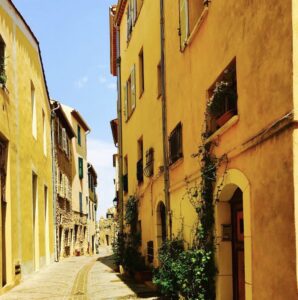
Port Vauban is an integral part of the economy of Antibes being Europe’s largest marina by tonnage, welcoming all types of sailing and motor yachts from fishing boats to superyachts. Since the 1980’s, the Quai des Milliardaires – better known as the IYCA – has been able to accommodate up to 19 superyachts. From 2020, Port Vauban is undertaking a €135 million renovation project which will revamp amenities and services.
If you visit Antibes – whether as yacht crew or a tourist – here are Antibes Yachting’s suggested activities and attractions in Antibes:
10 things to see and do in Antibes
1. Visit the Marché Provençal
The covered market at Cours Massena is worth visiting. In the Middle Ages, the buildings that are beside the market were part of the old village at the gates to the fortified city. At number 21, was the home of Marie-Rosalie Lamarre who became the wife of Massena, Marshal of France, Duke of Rivoli and Prince of Essling. From the 1930’s the market was planted with hackberry trees to provide shade to the market sellers, however the trees were later removed and the covered hall put up. In Massena’s honour, the market zone was renamed Cours Massena.

Marché Provençal in Antibes is one of the most popular markets on the Côte d’Azur
Today, you can buy cheese, fruits, vegetables, cured meats, seafood, herbs, tapenade, flowers and artisan products such as soap. Don’t miss trying the socca located at the top end of the market by La Tour.
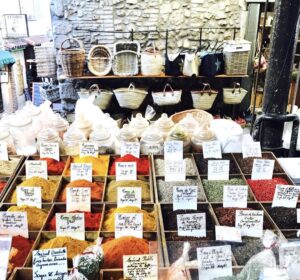
2. Discover the local museums in Antibes
Antibes was founded by the Greeks as Antipolis and settled by the Romans so it has a vast history as a defensive outpost and maritime hub. As well, a number of artists, writers and painters lived here or were inspired by Antibes so there is plenty to see at local museums.
The Château Grimaldi, formerly a residence of Monaco’s ruling family, now houses the Picasso Museum. Pablo Picasso used part of the castle as a studio and donated around 150 works including ‘The Goat and ‘La Joie de Vivre’.
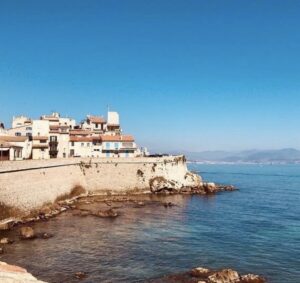
The Musée d’Archéologie situated at the end of the remparts and before the boules pitch near Salis beach has displays that were salvaged from shipwrecks from the Middle Ages.
Musée Peynet, located at Place Nationale, is dedicated to the artwork of Raymond Peynet and the exhibitions include ink drawings, cartoons and lithographs. Peynet is most famous for his works based on two characters he named ‘The Lovers’ or Les Amoureux – you can see a sculpture in the square outside the museum depicting the two figures.

Raymond Peynet is most famous for his works based on two characters he named ‘The Lovers’ or Les Amoureux – you can see a sculpture in the square outside the Peynet Museum depicting the two figures.
The Musée de la Carte Postale on avenue Tournelli has thousands of postcards – you can learn about the history of them and the evolution of postcards in this niche museum.
3. Explore Antibes on foot
Antibes comes into its own with scenic walking trails that feature town and coastal views. Here are some suggestions in or near Antibes:
- Walk the remparts from Port Vauban along Promenade Amiral de Grasse to the Archaeology Museum. It’s paved and flat all the way.

- My favourite walking trail is the Sentier de Tire-Poil, also known as the Cap d’Antibes coastal walking trail. You can park at Plage Garoupe and follow the coastal pathway; it’s rocky and has lots of steps so not suitable if you have a baby stroller but it’s fine for dog walking. The circuit leads past Villa Eilenroc and Anse d’lArgent Faux with great scenery and coastal views. Wear comfortable footwear and take water as it gets hot in summer!
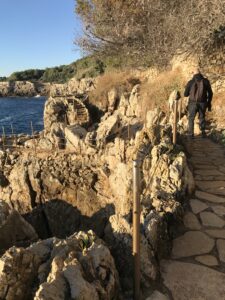


The Sentier de Tire-Poil, also known as the Cap d’Antibes coastal path, is a great scenic walk.
- From Boulevard Albert 1er in Antibes, stroll along Plage de la Salis beachfront and climb the steps at Chemin de Calvaire just past the small port at the end. The steps lead up to the Garoupe lighthouse and the small Chapelle de la Garoupe. The steps are rocky so wear comfortable shoes; you will notice some religious santons on the way up the steps. The lighthouse is not open to the public. During summer there is a small cafeteria on the plateau there which serves cold drinks and snacks.
- Head towards Antibes shipyard and you can do a circuit around the outside of Fort Carré. The path is gravel and rocky so wear comfy shoes.
4. Wander around Safranier
If you visit Antibes, you will probably stop by Safranier which is a small quarter tucked in behind the remparts. In fact, it is a free commune and has its own mayor. Safranier isn’t a big area but it has pretty streets to wander such as Rue du Bas Castelet and Rue du Haut Castelet and the famous Greek poet Nikos Kazantzaki once lived here. The commune also host some fun events each year such as a Pesto festival, Buche de Nöel (Christmas log) event, a chestnut festival and a local competition with square boules.

The free commune of Safranier has pretty, flower-bedecked streets (image: Antibes JLP tourism)
5. Go shopping
The fact that Antibes old town is condensed is a blessing for locals and visitors if you’re looking to go shopping. Shopping in Antibes is mostly centred around a few key streets (There is a new retail and residential development taking place near the main playground which will include retail stores but it is not due to open for a while). Boutiques in Antibes offer everything from souvenirs to books, household goods, clothing or gifts. Head to Rue James Close, Rue Sade, Rue Thuret or Rue de la Republique if you’re limited for time. Antibes also has regular town markets selling antiques, clothing, jewellery and crafts.
6. Experience an Antibes event
While 2020 has been quiet for events due to Covid-19, Antibes hosts many traditional and lively events. No matter the time of year you visit Antibes, you can experience life as a local. Don’t miss participating in Les Voiles d’Antibes, Fête de la Musique, the Bataille des Fleurs or Déantibulations, an annual celebration of arts and performance that takes place in Antibes streets and public squares.
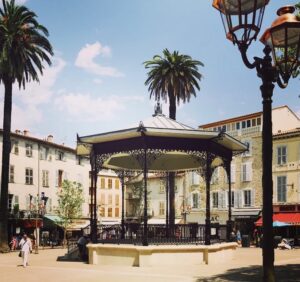
Antibes hosts a number of events yearly including live music, traditional festivals and sailing regattas.
7. Follow in the footsteps of artists
The French Riviera has welcomed creative personalities throughout the ages and Antibes was a drawcard for many painters – I’ve already mentioned Picasso, but it has also provided an inspirational backdrop for Monet, Boudin and Renoir.
If you want a modern artistic fix, head to Bastion St Andre near the IYCA Antibes where you can see ‘Le Nomade’ a cool sculpture by Spanish artist Jaume Plensa. Next, in the arcades under the rempart walls on Boulevard d’Aguillon you can find small artist workshops selling glassworks, ceramics or paintings. Each year, Antibes also hosts the Antibes Art Fair across from Port Vauban where keen buyers can snap up art, antiques, vintage jewellery and furniture.

‘Le Nomade’ by Jaume Plensa is a large-scale sculpture overlooking the sea in Antibes
Antibes is part of a free art trail called ‘La Route de la Côte d’Azur des Peintres’ which features over 60 stands across the French Riviera recreating the perspectives of famous artists. The trail includes Antibes, Grasse and Villefranche-sur-Mer; see more info here: Côte d’Azur des Peintres
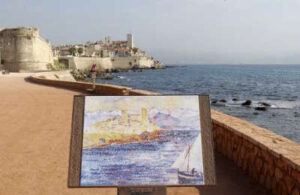
Antibes has provided inspiration for many writers and artists.
8. Check out Antibes’ beaches
Antibes has a number of beaches to discover. As with most of the French Riviera, summer months are busy so be prepared and arrive early!
- Plage de la Gravette is sandy and functions as the town beach, located right beside Port Vauban – it gets busy in summer because of its location.
- Plage de la Salis and Ponteil are two sandy beaches a short distance from old town Antibes – there are ‘snacks’ (food kiosks) located there, public toilets and a sailing club where you can hire kayaks, windsurfers etc. If you want a private beach, Royal Beach has a nice outlook on the sea and offer loungers and umbrellas for a fee.
- A bit further from Antibes, Plage de la Garoupe has a small public beach (super busy in summer) and private beach clubs at Plage Keller and Plage Joseph.
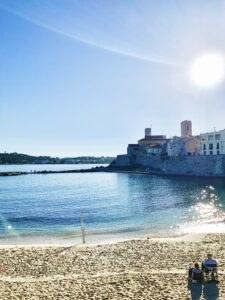
Plage Gravette is the town beach in Antibes, located right beside Port Vauban
9. Try water sports
Water sports fans can make a beeline for a number of places to try water sports in or near Antibes. Plage de la Salis is the place to go to rent small catamarans, windsurfers or kayaks. Paddleboards can be rented at Plage Garoupe in summer or a number of companies based at Port Gallice. For wakeboarding, water skiing or parasailing it’s best to head to Juan les Pins. Occasionally, there are storms where the usually calm sea has waves and you’ll see surfers by the Bord de Mer at Fort Carré or off Plage des Ondes, and kitesurfers jumping the waves off Plage de la Salis.

10. Experience the bars and restaurants in Antibes
Antibes has everything from French bistros to wine bars and English-style pubs. For bars, most of the action takes place on Rue Aubernon (Drinkers Club, Café Brun, Melting Pot, Pablo, Happy Face), Boulevard d’Aguillon (Latinos, Happy Face) and a few other select locations (Blue Lady, The Duke pub, the Absinthe bar). Restaurants include Michelangelo, Petit Cageot, Bistro Margaux, Le Figuier de St Esprit and Le Phenicia. Best coffee in town is from La Torref de Fersen or Nomads Coffee.
I hope you enjoyed my post about Antibes. Please share this post and tell us what you loved in the comments!






